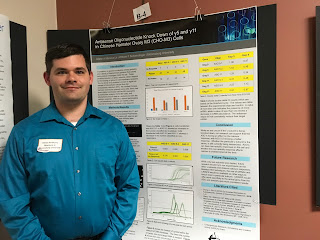Sean Hartzell, recent graduate of the Master's of Biology program and now adjunct faculty member in the Biological and Allied Health Sciences (BAHS) department at Bloomsburg University recently published a poem about turtles in
Chelonian Conservation and Biology.
 |
| Photo by Sean Hartzell |
Chelonian epitaph
Sean M. Hartzell
I trod upon last autumn's leaves,
winter's chill still on the breeze.
Into the swamp, I search for spring,
but still too cold, no frogs yet sing.
I look and see a striking sight,
a turtle's shell, protruding, white.
Your carapace, bleached, your upper half,
your memory, your epitaph.
I sit and ponder, as I should,
how may seasons you knew this wood?
While somber feelings fill my heart,
I know that this is nature's part.
A natural death, so odd it seems,
for turtles should be, a more common theme.
Not in a pot, or on the road,
or taken far away from your abode.
And so, I leave your memory here,
and feel renewal, that spring is near.
Sean also published an article with Dr. Steve Rier, professor of BAHS, in the Journal of the Pennsylvania Academy of Science entitled, "A crayfish survey of the fishing creek watershed in northeastern Pennsylvania suggests widespread prevalence of a nonindigenous species and the absence of a native congener". Additionally, he coauthored a note with a biology undergraduate student, Cody Pavlick, and former BAHS faculty member Amber Pitt, regarding hellbender salamander behavior in the journal Herpetological Review.




















